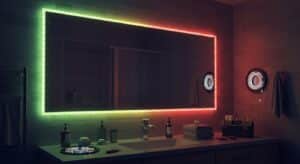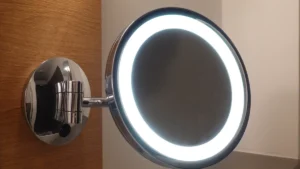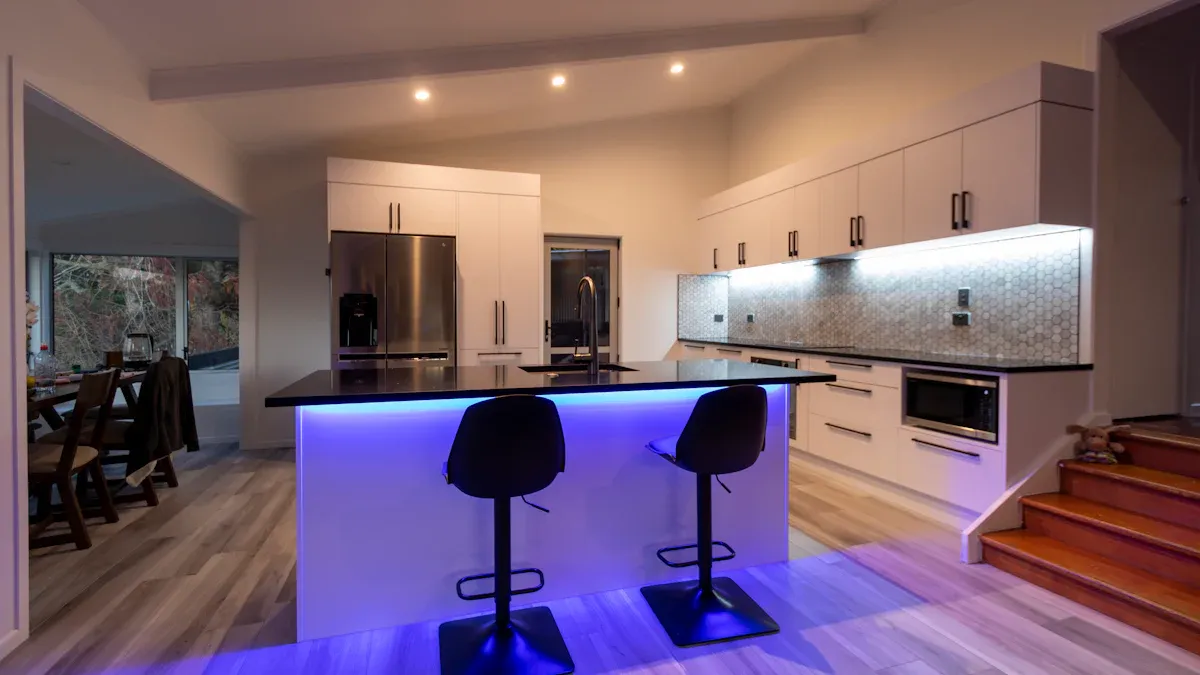
Choosing the best LED strip cove lighting design for your space can transform it into something stylish and functional. These lights emit a soft glow, making them ideal for enhancing the aesthetics of a room. High-quality lights, such as those with a colour rendering index (CRI) of 98 or above, provide natural-looking illumination that complements your design. Additionally, the dimensions of your room and the height of the ceiling are crucial factors in selecting the appropriate brightness and strip length. By opting for the right LED strip cove lighting design, you can seamlessly blend beauty and practicality.
Key Takeaways
Pick LED strips with a high Colour Rendering Index (CRI) of 98+. This gives natural light and makes your room look better.
Choose the right brightness for your room size. Use at least 450 lumens per foot for good cove lighting.
Think about colour temperature. Warm light (2700K–3000K) feels cosy. Cool light (4000K–5000K) works well for work areas.
Go for LED strips with adjustable colour temperatures. This lets you change between warm and cool light for different moods.
Install properly by measuring your space and using strong glue. This avoids mistakes and helps your LED strips last longer.
Understanding LED Strip Cove Lighting Design
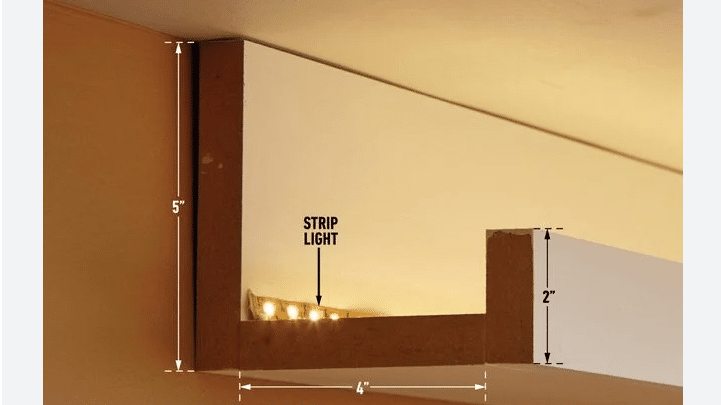
What Are LED Strip Lights?
LED strip lights are thin and bendable lights. They have small LED chips on a strip. These strips give even light along their length. This makes them great for many uses, like cove lighting. You can cut or extend them to fit your space. They are very flexible and easy to use. With sticky backing, they are simple to stick in place. You can even use them in tight or curved spots.
Modern LED strips come in many sizes and brightness levels. They also have different colour tones to choose from. You can pick warm, cosy light or bright, cool light. These lights let you match your space perfectly.
Benefits of LED Strip Lights for Cove Lighting
LED strip lights have many good points for cove lighting. First, they save energy and use less power than old lights. This means lower electricity bills and less harm to the planet. They also last a long time, so you don’t replace them often. This saves you money and effort.
Another great thing is their sleek and modern look. Using white ceilings can bounce the light around. This gives a soft and even glow. LED strips can also dim, so you control the room’s mood. Some even work with smart systems. You can change brightness and colours from your phone. This makes them easy and fun to use.
Why LED Strips Are Ideal for Modern Cove Lighting
LED strips are perfect for modern cove lighting because they are flexible and work well. Their slim shape fits into small spaces easily. They are simple to set up and need few parts. This makes them great for DIY projects or professional jobs.
LED strips give bright and clear light that looks natural. With a CRI of 98 or more, colours look real and lively. They also work with smart systems for cool lighting effects. You can highlight special features or create a calm vibe. LED strips are a top choice for stylish and useful lighting.
LED Strip Light Buying Guide: Key Comparison Factors
Brightness (Lumen Output)
Measuring Brightness for Cove Lighting
When picking LED strip lights, brightness is very important. Brightness, measured in lumens, shows how well the light lights up your room. For cove lighting, choose strips with at least 450 lumens per foot (1500 lumens per metre). This is like the brightness of T8 fluorescent lamps and gives enough light. For softer lighting, 600 lumens per metre might be enough.
The number of LEDs on the strip also matters. More LEDs, like 36 LEDs per foot (120 LEDs per metre), spread light evenly without dark patches. Make sure each LED uses no more than 0.2 watts. This stops overheating and helps the lights last longer.
Recommended Brightness Levels
The right brightness depends on your room size and ceiling height. Bigger rooms or taller ceilings need stronger LED strips. Smaller rooms need less bright lights. Use white ceilings to reflect the light better. This spreads the light and makes it look soft and even.
Colour Temperature (CCT)
Warm vs Cool Lighting for Modern Designs
Colour temperature, measured in Kelvin (K), changes how a room feels. Warm light (2700K–3000K) feels cosy and welcoming. It’s great for homes, like living rooms or bedrooms. Cool light (4000K–5000K) feels fresh and bright. It works well in offices or kitchens.
Think about what your room is for when choosing LED strips. Warm light is good for relaxing. Cool light helps you focus and work better. Pick the right tone to match your room’s purpose and style.
Adjustable Colour Temperature Options
For more options, pick LED strips with adjustable colour temperature. These let you switch between warm and cool light. You can change the light for different tasks or moods. Some even have smart controls. You can adjust them with your phone or voice. This makes your lighting more useful and fun.
Colour Rendering Index (CRI)
Enhancing Colours with High CRI
The Colour Rendering Index (CRI) shows how well a light shows colours. A high CRI makes colours look bright and real. For cove lighting, pick LED strips with a CRI of 90 or more. This makes your room look stylish and professional.
Ideal CRI Levels for Cove Lighting
Different CRI levels work for different spaces. The table below shows the best levels:
CRI Range | Description | Applications |
|---|---|---|
CRI 95 – 100 | Amazing colour; colours look natural and perfect. | Great for art galleries, fancy shops, and homes. |
CRI 90 – 95 | Excellent colour; most colours look bright and clear. | Best for kitchens and places needing vibrant colours. |
CRI 80 – 90 | Good colour; most colours look fine. | Works for most business spaces. |
CRI Below 80 | Poor colour; colours may look dull and unclear. | Not good for places needing accurate colours. |
For modern cove lighting, aim for a CRI of 95 or more. This makes your space look lively and beautiful. It improves both the look and usefulness of your room.
LED Size and Density
How Size and Density Affect Light
The size and number of LEDs on a strip matter a lot. More LEDs on a strip give smoother and even light. This stops dark spots or uneven brightness. For cove lighting, pick strips with at least 36 LEDs per foot (120 LEDs per metre). This gives a soft and steady glow across your room.
Surfaces near the lights also change how the light looks. White ceilings or shiny surfaces make the light brighter. Darker surfaces soak up light and make it dimmer. Use high-density LED strips with reflective surfaces for a neat and polished look.
Picking the Right Size for Your Cove
The size of LED strips should match your cove’s size and style. Thin strips work well in small coves as they fit neatly. Bigger spaces need wider strips with more brightness.
Here’s a simple guide to help you:
LED Strip Brightness (lm/m) | Minimum Total Length (metres) | Purpose |
|---|---|---|
500 | 40 | General Lighting |
1000 | 20 | General Lighting |
2000 | 8 | General Lighting |
Choose the right size and brightness to make your cove lighting look balanced and nice.
Wattage and Energy Efficiency
Finding the Right Power and Brightness
When buying LED strips, think about power use and brightness. Higher wattage strips are brighter but use more energy. For cove lighting, pick strips that are bright enough but don’t waste energy. Strips with good LED chips give bright light and save power.
Tips to Save Energy
Follow these tips to use less energy:
Use dimmable strips to change brightness as needed.
Pick strips that last long and keep their colour.
Add motion sensors or timers to turn lights off when not needed.
These steps help you enjoy great lighting while saving energy and helping the planet.
Quality Indicators
IP Ratings and Strength
The quality of LED strips is shown by their IP rating. This tells how well they resist dust and water. For indoor cove lighting, an IP20 rating works fine. For wet areas like bathrooms, choose strips with an IP65 rating or higher. Strong LED strips last longer, even in tough conditions.
Lifespan and Warranty
Good LED strips last for 50,000 hours or more. This means fewer replacements, saving you time and money. Always check the warranty from the maker. A longer warranty shows the product is reliable and high-quality.
Buying strong, good-quality LED strips keeps your cove lighting looking great for many years.
Matching LED Strip Lights to Cove Lighting Styles
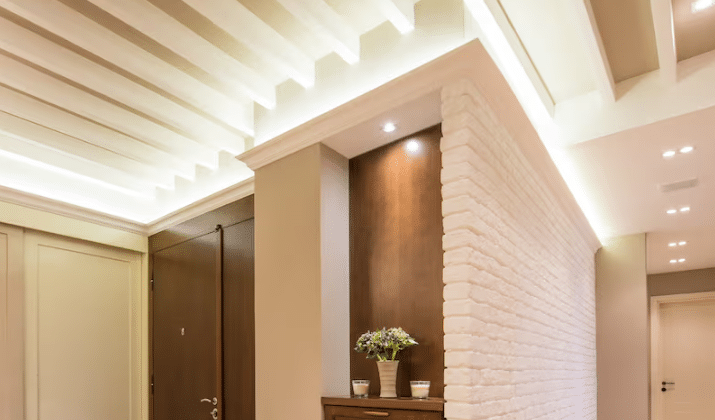
Minimalist Cove Lighting
Features of Minimalist LED Strips
Minimalist designs focus on being simple and stylish. For these spaces, pick slim LED strips that give soft, even light. Flexible strips with many LEDs ensure smooth lighting without dark spots. Choose strips with adjustable brightness for a gentle glow. This matches the neat look of minimalist rooms. A colour temperature between 3000K and 4000K works well. It gives a mix of warmth and clear light.
Examples of Minimalist Applications
Minimalist cove lighting often shows off design features like hidden ceilings or floating shelves. For example, place LED strips along ceiling edges for a glowing effect. You can also use them under cabinets or stairs for a modern look. These ideas make the space look nice and add useful light without being too much.
Contemporary and Layered Designs
Combining LED Strips with Other Lights
Modern designs often use layers of light to add depth. Pair LED strips with hanging lights, wall lights, or ceiling lights. This mix lets you light up key areas while keeping the design balanced. For instance, use LED strips for soft light and spotlights for focus.
Creating Depth with Cove Lighting
To add depth, place LED strips carefully in the cove. White ceilings reflect the light, making the room feel bigger. Try colour-changing LED strips for fun layers of light. Adjusting brightness and colour helps set the mood, whether it’s relaxing or lively.
Smart and Customisable Lighting
Benefits of Smart LED Strips
Smart LED strips are easy and flexible to use. You can control them with apps or voice commands. This lets you change brightness, colours, and schedules easily. They work well with smart home systems, syncing with other devices. This makes your space both functional and stylish.
Popular Smart Lighting Options
There are many smart lighting choices for modern needs. Popular ones include LED strips with adjustable colours, RGB lights for bright shades, and motion-sensing lights for ease. These features meet the need for energy-saving and flexible lighting.
Tip: When buying smart LED strips, pick ones with high CRI and good warranties for lasting quality.
Practical Tips for Installing and Maintaining LED Strip Lights
Getting Ready for Installation
Measuring and Planning the Area
Good planning makes installing LED strips easier. Follow these steps:
Look at reflective surfaces like white or shiny walls. These make lights brighter.
Measure your room and ceiling height. This helps pick the right strip length and brightness.
Choose simple-to-install LED strips to avoid problems.
Add dimming options to change the light’s brightness for different moods.
Make sure you can reach the strips for future maintenance.
Ask a lighting expert if you need help with the design.
Tools and Materials You’ll Need
Before starting, gather these tools and materials:
A measuring tape to get accurate sizes.
Scissors or a knife to cut the strips.
Sticky backing or clips to hold the strips in place.
A power supply that matches your LED strips.
A dimmer switch to control brightness.
Surge protectors to stop voltage spikes.
Tip: Check your tools and measurements twice to avoid mistakes during setup.
Tips for Installing LED Strips
Keeping LED Strips in Place
To make sure your LED strips stay secure:
Use strong adhesive backing on clean, flat surfaces.
Wipe the area to remove dust and grease before sticking.
Don’t pull or stretch the strips, as this can break them.
Avoiding Common Errors
Mistakes can shorten the life of your LED strips. Avoid these errors:
Don’t use strips longer than their maximum length. This can make them dim.
Match the power supply voltage to your LED strips.
Test the lights before sticking them down to ensure they work.
Caring for and Fixing LED Strips
Cleaning and Looking After LED Strips
Keep your LED strips in good shape by doing this:
Wipe them gently with a soft, dry cloth to remove dust.
Check the connections often to make sure they’re tight.
Use a dimmer to lower brightness and make the strips last longer.
Solving Flickering or Dim Lights
If your LED strips flicker or look dim:
Check for loose wires or bad connections.
Use surge protectors to handle sudden voltage changes.
Replace broken parts of the strip with matching new ones.
Note: High-quality LED strips have fewer problems, so buy reliable ones for better results.
Picking the right LED strip lights can improve your space. They combine beauty, usefulness, and good quality. Strips with a high CRI, like 98 or more, show colours clearly and naturally. Cove lighting spreads soft, even light across a room. This makes the space look cosy and inviting. Experts say modern LED strips are great for this purpose. Choose strips that fit your design and work well. This way, your space will look nice and be practical too.
FAQ
What is the best brightness level for cove lighting?
Pick LED strips with at least 450 lumens per foot for bright cove lighting. For softer light, go for 600 lumens per metre. The right brightness depends on your room’s size and ceiling height. Test the light to make sure it fits your design needs.
Can I install LED strip lights without professional help?
Yes, you can! LED strips are easy to set up. Use sticky backing, follow the instructions, and measure carefully. For tricky designs or wiring, ask an expert. A DIY setup saves money and lets you be creative.
How do I choose the right colour temperature?
Think about how you’ll use the room. Choose warm light (2700K–3000K) for relaxing spaces like bedrooms. Pick cool light (4000K–5000K) for work areas like kitchens. Adjustable strips let you switch tones for more options.
Are smart LED strips worth it?
Yes, they are! Smart LED strips are handy and customisable. You can change brightness, colours, and schedules using apps or voice commands. They work well with smart home systems, adding style and ease. Buy good-quality ones for better results.
How can I maintain my LED strip lights?
Clean them gently with a soft cloth. Check connections often to stop flickering. Use dimmers to make them last longer. Replace broken parts quickly. High-quality strips can last over 50,000 hours with proper care, saving you money.
Tip: Always choose LED strips with a warranty for extra confidence.
See Also
Selecting The Perfect LED Strip Lights For Linear Lighting
Versatile COB LED Strips For Innovative Design Solutions
Creative LED Strip Lighting Concepts For The Festive Season

